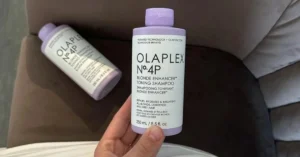Are you prepared to transform your skincare regimen? Hyaluronic acid and salicylic acid, the emerging heroes in the world of skincare, have generated significant excitement due to their amazing advantages. However, the essential question remains: Can combining these two potent ingredients really elevate your skin to unprecedented levels?
Join us on this captivating journey as we dive deep into the realm of beauty, uncovering the secrets behind salicylic acid’s acclaim and discovering the remarkable transformations it can bring to your skin. It’s time to unlock the door to your most radiant self. Let the transformation begin!
Table of Contents
Hyaluronic Acid + Salicylic Acid
Hyaluronic acid is a wonder ingredient that is known for its incredible ability to bind up to 1000x its weight in water, making it a potent humectant. By drawing and holding water within your skin, it effectively nourishes and hydrates, leaving you with a supple and youthful appearance.
Salicylic acid, on the other hand, is a beta hydroxy acid that gently exfoliates the skin, ridding it of dead cells and helping to unclog pores. It is particularly useful for those with acne-prone or oily skin.
yeah! i have/had oily skin as well and a lot of times making sure its moisturized properly with things like hyaluronic acid will tame the oil and keep it hydrated but not greasy/oily Not sure if you’ve done it before, i’m just speaking from personal experience
— madele ˚₊· ͟͟͞͞➳❥ (@madeleboo) April 18, 2018
The good news is that you absolutely can mix hyaluronic acid with salicylic acid! Combining these two skincare acids can help to strike a perfect balance between moisture retention and exfoliation, ensuring your skin stays fresh and radiant while keeping pesky breakouts at bay. So go ahead, give your skincare routine a much-needed boost by incorporating these two amazing ingredients!
Hyaluronic Acid: Properties and Benefits

Imagine a powerful skincare ingredient that can plump up your skin, reduce the appearance of wrinkles, and improve hydration – that’s where the magic of hyaluronic acid comes in! Combining hyaluronic acid and salicylic acid can take your skincare game to a whole new level.
Role in Skincare
Hyaluronic acid plays a crucial role in maintaining your skin’s moisture and elasticity. It has the unique ability to attract and retain water, which means it can provide your skin with a generous dose of hydration. Moreover, hyaluronic acid helps wounds heal faster and can reduce scarring by promoting cell regeneration and overall skin health.
Have you ever struggled with clogged pores and acne? The fantastic combination of hyaluronic acid and salicylic acid can help you there too. While hyaluronic acid hydrates and rejuvenates the skin, salicylic acid works as an exfoliant, clearing out dead skin cells and unclogging pores. Together, they work in harmony to provide you with clear, supple, and refreshed skin.
Application in Cosmetic Procedures
Hyaluronic acid’s hydrating properties and ability to retain water have made it a popular ingredient in cosmetic procedures. One such application is dermal fillers, where hyaluronic acid is injected into the skin to add volume, smooth out wrinkles, and restore a youthful appearance.
In conclusion, you deserve the best skincare ingredients to help you maintain a healthy and radiant complexion. So go ahead, embrace the wonders of hyaluronic acid and salicylic acid and keep your skin looking fabulous!
Salicylic Acid: Properties and Functions

When it comes to skincare, mixing hyaluronic acid and salicylic acid brings the best of both worlds. But let’s dive into understanding the properties and functions of salicylic acid first.
Use in Skincare
Salicylic acid, known for its exfoliating properties, offers many skin benefits. It works by loosening the fluid that binds surface skin cells together, allowing dead skin cells to slough off and revealing smoother, brighter skin underneath. You’ll find it commonly used in products like cleansers, toners, and spot treatments as a gentle exfoliant and acne-fighting ingredient.
Acne Treatment and Prevention
Salicylic acid proves highly effective in treating and preventing acne, thanks to its unique ability to dissolve sebum buildup within pores. It penetrates deep into the skin, breaking down excess oil and dead skin cells while also unclogging and cleaning the pores. This reduces inflammation and creates an antibacterial environment, which helps prevent acne from forming in the first place.
Incorporating salicylic acid in your skincare routine can significantly improve the appearance of acne-prone skin, giving you a more refined and balanced complexion.
In conclusion, salicylic acid is a powerful ingredient in skincare products with numerous benefits. When combined with hyaluronic acid, you have a dynamic duo that exfoliates, hydrates, and revitalizes your skin. So why not give these two superheroes a try and show your skin some love?
Combining Hyaluronic Acid and Salicylic Acid

Are you tired of searching for the perfect combination of skincare products? Look no further! You can now amplify your skincare routine by combining hyaluronic acid and salicylic acid to achieve a flawless complexion.
Benefits and Synergy
Wondering how these two popular ingredients work together? It’s simple. Hyaluronic acid is a powerful humectant that helps retain moisture in the skin, making it appear plump and hydrated.
On the other hand, salicylic acid is a beta hydroxy acid that penetrates deep into the skin’s protective barrier, effectively removing excess oil and unclogging pores. This dynamic duo not only prevents acne breakouts but also minimizes the appearance of pores, giving your skin a smooth finish.
Moreover, using hyaluronic acid alongside salicylic acid enhances the skin’s moisture levels, reducing potential irritation or dryness caused by salicylic acid’s exfoliating properties.
Safety and Precautions

If you’re interested in combining hyaluronic acid and salicylic acid in your skincare routine, it’s crucial to understand their potential side effects and how to use them safely. Read on to discover some ways you can protect your skin and enjoy the benefits of both ingredients.
Possible Side Effects
While both hyaluronic acid and salicylic acid are generally considered safe, they may still cause some side effects. Hyaluronic acid tends to have fewer reactions, with adverse effects being rare. However, when using salicylic acid, be mindful of potential side effects like dryness, peeling, or irritation.
To minimize these issues:
- Start by applying a small amount of salicylic acid on a less visible area to test your skin’s reaction
- Gradually increase the frequency of usage, allowing your skin to adjust
- Always apply a moisturizer or hyaluronic acid after salicylic acid to counteract dryness
Sensitive Skin Considerations

For those with sensitive skin, it’s especially important to take caution when applying products containing salicylic acid, as it may cause irritation or excessive dryness. Hyaluronic acid, on the other hand, is suitable for all skin types and should not cause any problems.
To prevent unwanted reactions, consider:
- Patch testing products before incorporating them into your routine
- Opting for lower concentrations of salicylic acid, to minimize the risk of irritation
- Introducing one new product at a time, allowing your skin to adapt
By following these precautions, you can safely enjoy the benefits of hyaluronic acid and salicylic acid in your skincare regimen.
Combining Salicylic Acid with Hyaluronic Acid: Top Takeaways

Wow! Did you know that hyaluronic acid and salicylic acid can actually be a game changer when combined in your skincare routine? You might be surprised, but they could be the perfect blend for achieving healthy, nourished skin. Let’s dive into how these two power ingredients work together.
Salicylic acid is a beta-hydroxy acid that helps exfoliate your skin and remove dead cells, while hyaluronic acid is a humectant that retains moisture in your skin. Both of these acids have garnered a lot of attention for their individual benefits, but together, they can really offer a fantastic, balanced approach to skincare.
So, why should you consider combining these two ingredients? Well, if you have acne-prone skin, salicylic acid can help treat and prevent breakouts. Meanwhile, hyaluronic acid hydrates and soothes your skin, reducing the risk of dryness and irritation. This harmonious combination supports healthy skin without any adverse effects.
Let’s check out the pros and cons of using salicylic acid and hyaluronic acid together:
| Pros | Cons |
|---|---|
| Exfoliates & Removes Dead Skin Cells | May cause mild skin irritation for some |
| Provides Moisture Retention | Requires finding the right balance of both acids |
| Helps Treat & Prevent Breakouts | Both ingredients shouldn’t be overused |
| Combats Dryness & Irritation | Suitable for specific skin types |
Always remember to listen to your skin and consult a dermatologist when trying new combinations. By doing so, you’ll be able to enjoy the benefits of hyaluronic acid and salicylic acid, giving your skin the care it deserves.
Now that you have the top takeaways for combining salicylic acid with hyaluronic acid, don’t hesitate to make your skincare routine work for you. With the right balance and application, your skin will feel cleaner, more nurtured, and truly rejuvenated.
FAQ:

What is the best combination with salicylic acid?
Niacinamide + Hyaluronic Acid: The Perfect Pair for Salicylic Acid. This combination not only enhances the benefits of salicylic acid but also provides added hydration, reduces redness, improves skin texture, and offers anti-aging properties.
What should you not mix with hyaluronic acid?
When using hyaluronic acid, it’s best to avoid combining it with ingredients that have a high concentration of acids, such as alpha hydroxy acids (AHAs) or beta hydroxy acids (BHAs), as they can potentially disrupt the efficacy of hyaluronic acid or cause irritation.
Should I moisturize after salicylic acid?
Yes, it is recommended to moisturize after applying salicylic acid. Salicylic acid can be drying, so using a moisturizer afterwards helps to replenish the skin’s moisture barrier and prevent dryness or irritation.
How long to leave salicylic acid on face?
One skincare technique gaining popularity is the “60 seconds rule.” It involves massaging salicylic acid or any cleanser onto your face for a full minute before rinsing. This prolonged contact time maximizes the effectiveness of the product, ensuring deeper cleansing and potential enhanced results for your skin.
What goes first salicylic acid or hyaluronic acid?
Salicylic acid should be applied first before hyaluronic acid. Salicylic acid helps exfoliate and treat the skin, while hyaluronic acid provides hydration. Applying salicylic acid first allows it to penetrate the skin effectively, followed by hyaluronic acid to lock in moisture.
If you liked this blog post about the topic: Enhancing Skincare: Hyaluronic Acid + Salicylic Acid, don’t forget to leave us a comment down below to tell us about your experience with it.





